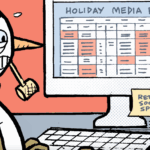Music video network Vevo has evolved a lot in six years.
After shutting down its consumer-facing website and mobile app in 2018, it embraced CTV with its own free ad-supported channels for different music genres, including pop and country.
Rob Christensen joined Vevo in 2019 as EVP of global sales and to oversee its FAST streaming TV business.
“It’s really hard – and expensive, as it turns out – to get users off YouTube and into your own experience,” Christensen says. “But the TV strategy has been a really good one.”
Now that ad-supported streaming models are becoming more profitable (see Paramount and Netflix), Christensen predicts that social video will be the next big frontier to cross – or, more specifically, where “social and television converge.”
Christensen shares his take on the rise of social video and where Vevo fits into the bigger picture.
AdExchanger: What is Vevo’s relationship to social video, considering how many people discover new musicians via platforms like TikTok?
ROB CHRISTENSEN: It’s a little complex, because it’s connected to the level of support that the music labels give to certain platforms. For example, earlier this year, Universal Music Group was off TikTok, and then Taylor Swift was on TikTok, so UMG’s suddenly back on TikTok. Even the labels are still figuring this out.
We want to maximize audience recapturing and the best ways for new artists and new content to get discovered. We root ourselves in TV, but we know it’s not the only place in the market right now that has an influx of viewership. And so we have to play in all those spaces.
Some have argued that all video – not just streaming and linear, but also social – should be thought of similarly. Do you agree?
I lean more toward yes than I ever have before. The next question, then, is what do you pay for it? What do you sell it for? Depending on where the impressions are, it’s always going to be supply and demand.
I heard many cases during this year’s upfronts of advertisers that previously spent large volumes on mid-tier to long-tail cable are starting to replace those GRPs and rating points within social because the price point is very similar. And why is that? Because there’s an ocean of availability within the social platforms. But only the top 1% to 5% of that traffic is premium.
What’s holding brands back from investing more in social?
Transparency is an issue. The environments are so big, and brands still require, as they should, control of the content they’re adjacent to. I think you’ll start to see more YouTube Select or Google Preferred models, where platforms lean more on their best content partners to maximize price, yield and brand safety.
Do you anticipate social platforms will start to cooperate more on the transparency front?
 It’s really hard to grow without getting smarter about how you organize your impressions and who you let help you. Look at YouTube, which generated $31 billion in ad revenue last year.
It’s really hard to grow without getting smarter about how you organize your impressions and who you let help you. Look at YouTube, which generated $31 billion in ad revenue last year.
Even they have publicly started to remove some of the friction points and play nicer in the sandbox, letting partners like us represent our own inventory and our content, but still giving advertisers credit toward their YouTube commitment.
That’s one example that makes me want to answer your question with “yes.”
What more would you want to see as the social video landscape expands?
From an ad ecosystem perspective, I would like to see more platforms be open to hosting premium content and participating in inventory shares with those partners. It’s hit or miss right now.
Some partners will say, “Sure, we’ll take your content, but we want all the ad sales.” That never worked in television and that won’t work long term in social or in CTV.
This interview has been lightly edited and condensed.
Questions? Comments? Concerns? Float ’em my way at victoria@adexchanger.com.
For more articles featuring Rob Christensen, click here.












